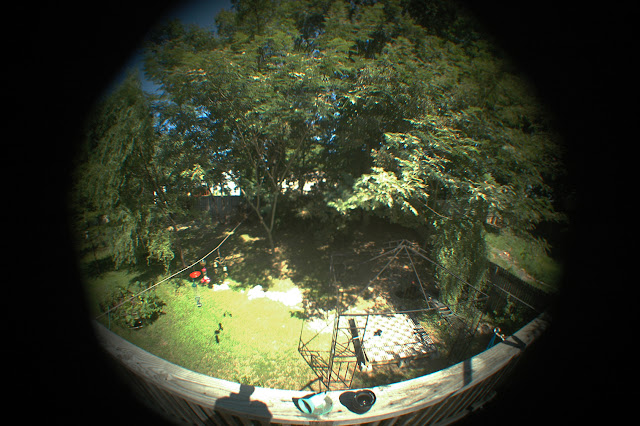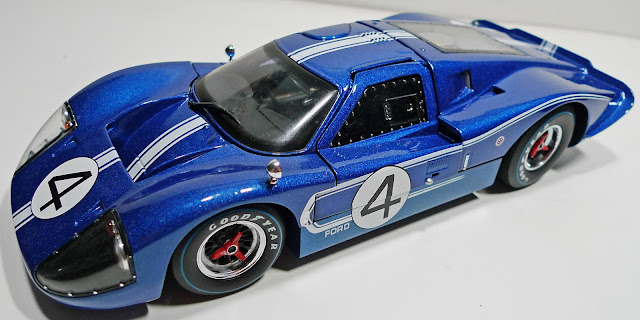Gentle reader,
Wow! My last post about Ford GT and Porsche 917 race cars is quite the hit: 561 page views yesterday and more than 400 so far today. It can be seen here:
Previously, I had written about trying a high-quality auxiliary lens Olympus made for it's top-of-the-ZLR-line: IS-3DLX camera. It can be seen here:
The Robb Collections: How to get quality wide-angle photos with a DSLR inexpensively!
As the article notes, they were made for a high quality 35mm film camera and thus fully coated with top-quality glass elements.
I was looking through pictures from over the years and saw a lens that I'd come across long ago made by Canon for their top-flight Super-8mm movie camera. It has 67mm threads on the camera-end and screws onto the front of that camera's lens or any other lens that has 67mm filter threads. I'd used it in my 35mm film days on generic "T-mount" 400mm and 500mm lenses. Seeing that lens again made me think, "What if I had another one and tried it on my Tokina (100-400mm) lens on the Nikon?" Ebay to the rescue and sure enough there were a couple of them. Snagged one and it arrived in the original box sans lens caps and leather case. But for $4.99, who can complain? Not me. Here is is on the front of the Tokina 100-400mm zoom lens.
As you can see, it is called: C-8 Tele Converter 1.4X. There are others of the same name but they appear to be smaller, yet magnify 1.6X. Completely different on the mounting end.
Now, there are special SLR camera teleconverter lenses made for decades that usually have four lens elements with the better ones having seven lens elements. They mount between the camera body and the lens you want to magnify. The trouble with these is the light loss. A typical 2X teleconverter while making the image twice as large, it cuts the light available to the film or sensor by one half. Here is an excellent article on the subject: Teleconverter Tutorial
I've never seen that site before, but it looks like they know what they are talking about. If you look on Google or eBay for front-mount auxiliary lenses you will see THOUSANDS of them. Factories in China must be cranking them out like crazy. Many have: MACRO on them as well. Google Macro to see what that means.
So, back to THIS front-mount auxiliary 1.4X Canon lens. It is all metal and glass, so it is heavy. The glass does not appear to be coated. This will hurt the resolution of the images. The one good thing about front-mount auxiliary lenses is they do not cut the light down. In other words, if your lens is f2.8, that is what it will still be with a front-mount auxiliary lens. So, lets see some more pictures:
I bought an add-on lens-mount bracket. Since this lens is so long, getting a stable image with the camera's own tripod mount is iffy at best. This one is made for a larger diameter lens barrel than the Tokina has, but it holds the lens/camera well with the spacer I made. (Visible above.)
However, once the heavy Canon lens is added to this mostly plastic lens, it became unstable and I had to slide the bracket all they way back to the body. Here are images with and without the 1.4X:
Above is at 400mm with the 1.5 multiplication factor on an APS-C sensor equipped camera, what Nikon calls "DX", it is equal to a 600mm lens on a full frame (35mm film sized) sensor, which Nikon calls "FX". Tripod mounted the image is nice and crisp and clear.
See how much bigger with the 1.4X front-mount auxiliary lens. Yes, note it is not quite as crisp and seems to have a slight color that isn't there in reality. I think the lack of lens coatings AND that this lens was made for a Super-8mm movie film camera. 8mm film is TINY compared to the sensor in my D70S. Image acceptable? Yes, worth entering into competition, no.
However, based upon the cost of the cheapest long lens that will mount on a DSLR, all of which are "T" mounted, manual focus and will not electronically couple with the camera's computer, then yes, getting the added reach is worth it.
Now, another of the multitude of front-mount auxiliary lenses out there, again that usually have MACRO on them, their quality is questionable at best. There is a choice. For instance, I want an 8mm fisheye, fish-eye if you prefer for my Nikon DSLR. There are many for less than $200. Again, they are manual focus and I don't think they will electronically couple with the camera. But I am not sure about that. Most appear identical despite the brand name.
Years ago, decades really, there was a camera company called SPIRATONE. Like J.C. Whitney for car parts, they sent out paper catalogs through the mail and sold all manor of camera related items including lenses and flashes with their own brand name. I can't speak for the flashes, but a lot of the lenses were made for Spiratone and other sellers by Sigma in Japan. Sigma lenses are of high quality and still made and sold today. In fact, I have a Sigma 70-300mm zoom for my Nikon.
"Fish eye" lenses are supposed to offer a 180 degree view. Depending upon the focal length, the image will be a circle with black all around or fill the picture with 180 degrees diagonally measured being 180 degrees with anything else in the "image circle" being lost. Google "image circle" for more on that.
Available most of the time on eBay are vintage front-mount auxiliary fisheye lenses which have a negative multiplication factor or 0.15. On a 50mm lens, which is what they are meant to mount to, that equates to 7.5mm and you will get a circular image with black all around. Such as:
According to the computer, these were from 2011 and it doesn't indicate which camera I used, so it may have been a film SLR. Today, I made these images with the Spiratone lens you will see below:
I was experimenting with a slave-triggered second flash in the above image. The clearest one of the bunch is this one and I closed the fisheye lens' aperture down, thus the less crisp circle.
This one is standing on my deck which is maybe seven feet up from the ground. Note the railing, which is straight, curving away and how much there is to see.
The same place, but taken with a 19-35mm zoom lens at the 19mm end. On the Nikon D70S, this is about 28mm on a 35mm film or FX sensor size. A lot less to see, but it is not at all distorted.
The key, and this must be followed: The larger the maximum aperture of the lens you want to mound one of these beauties on, the better:
See that: 1:1.8? That means the lens is called: 50mm f.18. The LOWER the "F" number, the wider the maximum opening, thus the "faster" the lens. This is essential with these lenses:
If you look at these cheap "super wide angle" lenses you can screw on another lens, do their front element curve outward like this one? Nope.
See that silver strip with numbers? This lens has it's own internal aperture, f3.5 being the widest. You set it to the green numbers to tell it what focal length you have mounted it to. 50mm is recommended.
You can see just how tiny the lens' rear aperture is looking into it, above.
It adds significant length to the 50mm lens as you can see. No one buys fisheye lenses for accuracy, mostly for fun. The way they curve all straight lines near the edges of the image can make for some interesting pictures.
So, to conclude: If you can afford real, made-to-mount-on your-camera, fisheye or super wide angle lenses for your DSLR camera, buy them. But avoid buying inexpensive front mount auxiliary lenses that proliferate the Internet. The quality is bad, and since most SLR and DSLR lens bodies are mostly plastic, you could damage your lenses with the extra weight on the front of them. Those threads are for filters, not for any more glass than that. Vintage X0.15 lenses like this Spiratone are another matter, quality-wise.
Thanks for looking,
Scott





























































































